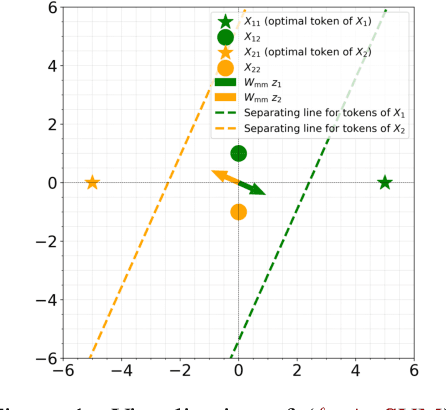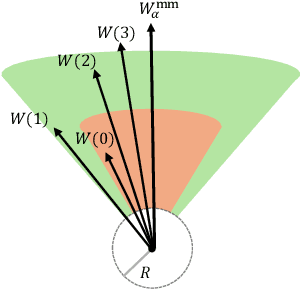Navid Azizan
Test-Time-Scaling for Zero-Shot Diagnosis with Visual-Language Reasoning
Jun 11, 2025Abstract:As a cornerstone of patient care, clinical decision-making significantly influences patient outcomes and can be enhanced by large language models (LLMs). Although LLMs have demonstrated remarkable performance, their application to visual question answering in medical imaging, particularly for reasoning-based diagnosis, remains largely unexplored. Furthermore, supervised fine-tuning for reasoning tasks is largely impractical due to limited data availability and high annotation costs. In this work, we introduce a zero-shot framework for reliable medical image diagnosis that enhances the reasoning capabilities of LLMs in clinical settings through test-time scaling. Given a medical image and a textual prompt, a vision-language model processes a medical image along with a corresponding textual prompt to generate multiple descriptions or interpretations of visual features. These interpretations are then fed to an LLM, where a test-time scaling strategy consolidates multiple candidate outputs into a reliable final diagnosis. We evaluate our approach across various medical imaging modalities -- including radiology, ophthalmology, and histopathology -- and demonstrate that the proposed test-time scaling strategy enhances diagnostic accuracy for both our and baseline methods. Additionally, we provide an empirical analysis showing that the proposed approach, which allows unbiased prompting in the first stage, improves the reliability of LLM-generated diagnoses and enhances classification accuracy.
Know What You Don't Know: Uncertainty Calibration of Process Reward Models
Jun 11, 2025Abstract:Process reward models (PRMs) play a central role in guiding inference-time scaling algorithms for large language models (LLMs). However, we observe that even state-of-the-art PRMs can be poorly calibrated and often overestimate success probabilities. To address this, we present a calibration approach, performed via quantile regression, that adjusts PRM outputs to better align with true success probabilities. Leveraging these calibrated success estimates and their associated confidence bounds, we introduce an \emph{instance-adaptive scaling} (IAS) framework that dynamically adjusts the inference budget based on the estimated likelihood that a partial reasoning trajectory will yield a correct final answer. Unlike conventional methods that allocate a fixed number of reasoning trajectories per query, this approach successfully adapts to each instance and reasoning step when using our calibrated PRMs. Experiments on mathematical reasoning benchmarks show that (i) our PRM calibration method successfully achieves small calibration error, outperforming the baseline methods, (ii) calibration is crucial for enabling effective adaptive scaling, and (iii) the proposed IAS strategy reduces inference costs while maintaining final answer accuracy, utilizing less compute on more confident problems as desired.
Constrained Online Decision-Making: A Unified Framework
May 16, 2025Abstract:Contextual online decision-making problems with constraints appear in various real-world applications, such as personalized recommendation with resource limits and dynamic pricing with fairness constraints. In this paper, we investigate a general formulation of sequential decision-making with stage-wise feasibility constraints, where at each round, the learner must select an action based on observed context while ensuring a problem-specific feasibility criterion. We propose a unified algorithmic framework that captures many existing constrained learning problems, including constrained bandits, stream active learning, online hypothesis testing, and model calibration. Central to our approach is the concept of upper counterfactual confidence bound, which enables the design of practically efficient online algorithms using any offline conditional density estimation oracle. Technically, to handle feasibility constraints, we introduce a generalized notion of the eluder dimension, extending it from the classical setting based on square loss to a broader class of metric-like probability divergences, which could capture the complexity of various density function classes and characterize the loss incurred due to feasibility constraint uncertainty. Our result offers a principled foundation for constrained sequential decision-making in both theory and practice.
Constrained Online Decision-Making with Density Estimation Oracles
May 11, 2025Abstract:Contextual online decision-making problems with constraints appear in a wide range of real-world applications, such as personalized recommendation with resource limits, adaptive experimental design, and decision-making under safety or fairness requirements. In this paper, we investigate a general formulation of sequential decision-making with stage-wise feasibility constraints, where at each round, the learner must select an action based on observed context while ensuring that a problem-specific feasibility criterion is satisfied. We propose a unified algorithmic framework that captures many existing constrained learning problems, including constrained bandits, active learning with label budgets, online hypothesis testing with Type I error control, and model calibration. Central to our approach is the concept of upper counterfactual confidence bounds, which enables the design of practically efficient online algorithms with strong theoretical guarantee using any offline conditional density estimation oracle. Technically, to handle feasibility constraints in complex environments, we introduce a generalized notion of the eluder dimension - extending it from the classical setting based on square loss to a broader class of metric-like probability divergences. This allows us to capture the complexity of various density function classes and characterize the utility regret incurred due to feasibility constraint uncertainty. Our result offers a principled foundation for constrained sequential decision-making in both theory and practice.
Activation-Informed Merging of Large Language Models
Feb 04, 2025Abstract:Model merging, a method that combines the parameters and embeddings of multiple fine-tuned large language models (LLMs), offers a promising approach to enhance model performance across various tasks while maintaining computational efficiency. This paper introduces Activation-Informed Merging (AIM), a technique that integrates the information from the activation space of LLMs into the merging process to improve performance and robustness. AIM is designed as a flexible, complementary solution that is applicable to any existing merging method. It aims to preserve critical weights from the base model, drawing on principles from continual learning~(CL) and model compression. Utilizing a task-agnostic calibration set, AIM selectively prioritizes essential weights during merging. We empirically demonstrate that AIM significantly enhances the performance of merged models across multiple benchmarks. Our findings suggest that considering the activation-space information can provide substantial advancements in the model merging strategies for LLMs with up to 40\% increase in benchmark performance.
In-Context Learning of Polynomial Kernel Regression in Transformers with GLU Layers
Jan 30, 2025Abstract:Transformer-based models have demonstrated remarkable ability in in-context learning (ICL), where they can adapt to unseen tasks from a prompt with a few examples, without requiring parameter updates. Recent research has provided insight into how linear Transformers can perform ICL by implementing gradient descent estimators. In particular, it has been shown that the optimal linear self-attention (LSA) mechanism can implement one step of gradient descent with respect to a linear least-squares objective when trained on random linear regression tasks. However, the theoretical understanding of ICL for nonlinear function classes remains limited. In this work, we address this gap by first showing that LSA is inherently restricted to solving linear least-squares objectives and thus, the solutions in prior works cannot readily extend to nonlinear ICL tasks. To overcome this limitation, drawing inspiration from modern architectures, we study a mechanism that combines LSA with GLU-like feed-forward layers and show that this allows the model to perform one step of gradient descent on a polynomial kernel regression. Further, we characterize the scaling behavior of the resulting Transformer model, highlighting the necessary model size to effectively handle quadratic ICL tasks. Our findings highlight the distinct roles of attention and feed-forward layers in nonlinear ICL and identify key challenges when extending ICL to nonlinear function classes.
Identifying Reliable Predictions in Detection Transformers
Dec 02, 2024Abstract:DEtection TRansformer (DETR) has emerged as a promising architecture for object detection, offering an end-to-end prediction pipeline. In practice, however, DETR generates hundreds of predictions that far outnumber the actual number of objects present in an image. This raises the question: can we trust and use all of these predictions? Addressing this concern, we present empirical evidence highlighting how different predictions within the same image play distinct roles, resulting in varying reliability levels across those predictions. More specifically, while multiple predictions are often made for a single object, our findings show that most often one such prediction is well-calibrated, and the others are poorly calibrated. Based on these insights, we demonstrate identifying a reliable subset of DETR's predictions is crucial for accurately assessing the reliability of the model at both object and image levels. Building on this viewpoint, we first tackle the shortcomings of widely used performance and calibration metrics, such as average precision and various forms of expected calibration error. Specifically, they are inadequate for determining which subset of DETR's predictions should be trusted and utilized. In response, we present Object-level Calibration Error (OCE), which is capable of assessing the calibration quality both across different models and among various configurations within a specific model. As a final contribution, we introduce a post hoc Uncertainty Quantification (UQ) framework that predicts the accuracy of the model on a per-image basis. By contrasting the average confidence scores of positive (i.e., likely to be matched) and negative predictions determined by OCE, the framework assesses the reliability of the DETR model for each test image.
Optimizing Attention with Mirror Descent: Generalized Max-Margin Token Selection
Oct 18, 2024



Abstract:Attention mechanisms have revolutionized several domains of artificial intelligence, such as natural language processing and computer vision, by enabling models to selectively focus on relevant parts of the input data. While recent work has characterized the optimization dynamics of gradient descent (GD) in attention-based models and the structural properties of its preferred solutions, less is known about more general optimization algorithms such as mirror descent (MD). In this paper, we investigate the convergence properties and implicit biases of a family of MD algorithms tailored for softmax attention mechanisms, with the potential function chosen as the $p$-th power of the $\ell_p$-norm. Specifically, we show that these algorithms converge in direction to a generalized hard-margin SVM with an $\ell_p$-norm objective when applied to a classification problem using a softmax attention model. Notably, our theoretical results reveal that the convergence rate is comparable to that of traditional GD in simpler models, despite the highly nonlinear and nonconvex nature of the present problem. Additionally, we delve into the joint optimization dynamics of the key-query matrix and the decoder, establishing conditions under which this complex joint optimization converges to their respective hard-margin SVM solutions. Lastly, our numerical experiments on real data demonstrate that MD algorithms improve generalization over standard GD and excel in optimal token selection.
Hard-Constrained Neural Networks with Universal Approximation Guarantees
Oct 14, 2024Abstract:Incorporating prior knowledge or specifications of input-output relationships into machine learning models has gained significant attention, as it enhances generalization from limited data and leads to conforming outputs. However, most existing approaches use soft constraints by penalizing violations through regularization, which offers no guarantee of constraint satisfaction -- an essential requirement in safety-critical applications. On the other hand, imposing hard constraints on neural networks may hinder their representational power, adversely affecting performance. To address this, we propose HardNet, a practical framework for constructing neural networks that inherently satisfy hard constraints without sacrificing model capacity. Specifically, we encode affine and convex hard constraints, dependent on both inputs and outputs, by appending a differentiable projection layer to the network's output. This architecture allows unconstrained optimization of the network parameters using standard algorithms while ensuring constraint satisfaction by construction. Furthermore, we show that HardNet retains the universal approximation capabilities of neural networks. We demonstrate the versatility and effectiveness of HardNet across various applications: fitting functions under constraints, learning optimization solvers, optimizing control policies in safety-critical systems, and learning safe decision logic for aircraft systems.
Adapting Differentially Private Synthetic Data to Relational Databases
May 29, 2024



Abstract:Existing differentially private (DP) synthetic data generation mechanisms typically assume a single-source table. In practice, data is often distributed across multiple tables with relationships across tables. In this paper, we introduce the first-of-its-kind algorithm that can be combined with any existing DP mechanisms to generate synthetic relational databases. Our algorithm iteratively refines the relationship between individual synthetic tables to minimize their approximation errors in terms of low-order marginal distributions while maintaining referential integrity. Finally, we provide both DP and theoretical utility guarantees for our algorithm.
 Add to Chrome
Add to Chrome Add to Firefox
Add to Firefox Add to Edge
Add to Edge